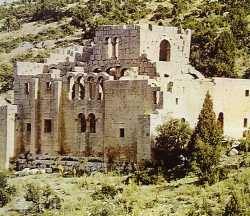|
|
|
|
|
 The Alacahan Monastery is one of the most important monuments of
the Christian period in Anatolia. It lies a little before Mut on the Karaman-Silifke
highway, and is situated on a terrace excavated from the side of the mountain. The Alacahan Monastery is one of the most important monuments of
the Christian period in Anatolia. It lies a little before Mut on the Karaman-Silifke
highway, and is situated on a terrace excavated from the side of the mountain. It commands a magnificent view of the plain, and would appear to have been approached in former times by steps leading up the slope from the plain below. A number of hermits' cells and an apsidal burial chapel hewn out of the rock would seem to have formed the original place of pilgrimage, and may well date from around 450 A. D. A little beyond these caves lies a basilica containing two rows of columns with corinthian capitals. After this church had fallen into ruin a small chapel was constructed by roofing the central nave and apse of the original basilica. The most interesting feature of this basilica is to be found in the reliefs on the side jambs and lintel of the door leading from the narthex into the main body of the church. At the sides the archangels Gabriel and Michael are to be seen trampling some figures under foot. Under one of the archangels is a bare-headed man with an ox and a bull, while under the feet of the other are two women with bare breasts wearing Phrygian head-dresses.
To the east of the basilica there is a large courtyard, and to the south of this a gallery 115 m. long with arches and columns. Remains of the steps leading up from the plain are to be seen beside this gallery, and it seems probable that it was here that visitors to the monastery arrived and performed a religious ceremony. Immediately opposite the steps there is a double baptismal pool. The plan of this baptistery, with its two symmetrical chambers, is quite unique in Christian art.
Here too one finds very rich decoration around the doors consisting of early period motifs such as beads, leaves and rows of palmettes. The small doors are surrounded by sacred leaves and bunches of grapes, as well as fish, another Christian symbol. The natural beauty of the site alone would make these ruins one of the most interesting and attractive of all ancient sites, while at the same time the artistic taste displayed in the unusual, rather ornate but distinctively regional stone decoration gives it an outstanding place in the history of art.
|
| |
Our Hotel | Turkey | Cappadocia | Daily Tours | Views | Guestbook | Request Form | Home |